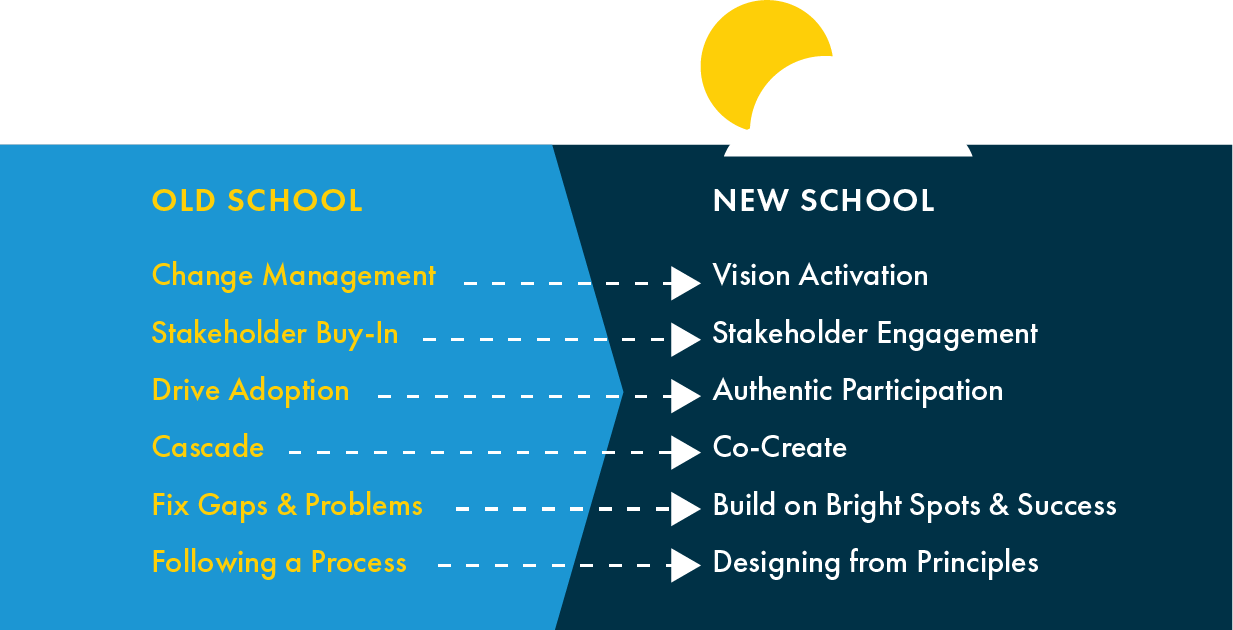Moving strategy from planning to implementation can feel like going into overtime with nothing in reserve. But when you know how to get people onboard with change, you can turn the game around. In his new book, The Strategy Activation Playbook, XPLANE CEO Aric Wood unpacks how to avoid the pitfalls of organizational change and use a human-centered approach to get your strategy to the finish line.
This post is an excerpt from “A Human-Centered Approach to Bring Your Strategy to Life: An Introduction to the Strategy Activation Playbook” webinar, the first of a two-part series. You can view the complete webinar here and learn more about the playbook here.
If you’re a changemaker working to transform your organization from the inside out, you know change is hard. It can’t be forced from the top—rather, it must be an authentic movement from within.
This requires a human-centered approach to change built upon a concept called the activation curve, which takes into account an organization’s various stakeholder groups, each of which has different wants and needs.
Beware the Activation Abyss
Strategy activation—that is, creating an authentic change movement from within—is the art and science of persuading people to align around, engage with, and adopt new ways of working to achieve a shared vision.
While classic change management maintains strategy goes straight from planning to execution, this is a false assumption. Between planning and execution there is a huge gap, which we call the activation abyss.
If we fail to take into account the thoughts, mindsets, and behaviors of the people we need to enact a plan, strategy will die in the abyss.
Clarity Counts
Case in point: Organizations spend about $160 billion a year on consulting strategy, yet research shows about 80% of those strategies are ultimately doomed to failure.
This is an incredible waste—and also an incredible opportunity. While most strategies are well-conceived, these solid plans often fizzle during execution.
As leaders, we can usually see more clearly than others where the organization needs to go—and how to get there. In this regard, most leaders can readily define where they want to take the organization.
However, the way is not necessarily clear to the rest of the organization. The destination may not be visible. Some paths might be frightening. Leaders need to close the gap between their vision and the perspective of people in the organization.

Three Reasons Strategies Fail
To close this gap, it’s critical to identify and address the factors that undermine even the best-laid plans.

#1 Poor line of sight.
For strategy to succeed, people need to know where the organization is headed, how they’re going to get there, why they’re making a change, what’s in it for them, and ultimately, their role in bringing strategy to life.

#2 Lack of employee engagement.
Remember, ideas cannot go directly from planning to execution. For strategy to succeed, people must be engaged in the change process because people support what they help build.

#3 No activation plan.
When you launch a new product or service to your customers, you typically create a marketing campaign. It’s the same with your employees. Once you build a strategy, you need to create an “activation campaign” to persuade them to want to make change happen.
Adopting a Modern Mindset
To address these sources of strategy failure, leaders must first lay the foundation for success by adopting a modern mindset.

This requires we shift our approach from traditional change management to activating a vision. We want to bring people alongside a change rather than forcing buy-in.
We can achieve this through co-creation, in which people contribute their own thoughts and ideas to shape the company’s change initiatives.
Finally, rather than fixing gaps and problems, we want to shift our thinking to building on successes, identifying best practices, and taking a more principle-based approach to designing the solution.
Addressing the Reasons Strategies Fail
When we put people first and build on modern principles of change, we can then move forward with activating change using a few practical tactics.
Align your navigation systems.
For strategy to succeed, an organization’s mission or purpose, set of values, culture, and guiding vision or strategy must be aligned. For example, if an organization wants to become a $2 billion company in the next 3 years but its purpose is to make the world a better place, this feels discordant. Strategy dies right away when purpose and mission are not harmonized.
Clarify your vision.
Many organizations launch a strategy without a plan in place to get there. We need to create a roadmap for people to see the steps we’re going to take to achieve our vision, and, importantly, show them what role they’ll play at each stage of the journey.
Create a change movement.
We can’t expect people to hear a strategy and just go and do it. We need to help them understand why the strategy is better for them and for the world. We need to actively involve people in the change (remember, people are more likely to support what they help build) so they join the change movement and move the initiative forward.
Invest in an activation plan.
To accelerate change, we need to create an activation plan that identifies actions and steps that will move people along the activation curve, from the point of learning new information to actually living it.
Shift behavior.
Employee mindsets, behaviors, and ways of working need to shift in support of the change we want to make. People may need to acquire new skills or ways of working and apply these new skills daily. By doing this, they will internalize the change.
Build on success.
Finally, we want to celebrate successes and share best practices around the organization to continue the momentum. This will engender new business as usual—and enable your organization to once again look to the future.
Want to learn more about making your strategy stick? The Strategy Activation Playbook: A Practical Approach to Bringing Your Strategies to Life is a comprehensive desk reference filled with tips and technique for getting your strategy off the ground. The playbook is available for purchase in the XPLANE shop and on Amazon.
Additional Resources
In addition to The Strategy Activation Playbook, we recommend the following resources for those wanting to take a deeper dive into strategy activation:
- Explore our free downloadable worksheets featured in The Strategy Activation Playbook.
- In XPLANE’s Strategy Activation course, apply key learnings from the playbook in real time and get live instruction from author Aric Wood, CEO of XPLANE.
- For added inspiration, tips, and techniques, we invite you to browse our extensive library of strategy activation blog posts.
